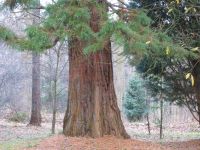Giant Sequoia, Wellingtonia - Sequoiadendron giganteum
English name:
Giant Sequoia, Wellingtonia
Scientific name:
Sequoiadendron giganteum
Family:
Cupressaceae (Cupressus)
Height:
to 35 M in Denmark (to 100 M in California)
Flowering:
Spring
Range:
Sierra Nevada mountains, California, U.S.A.
 |
 |
 |
The 47 year-old Giant Sequoia in the photograph can be found south of the Arboretums main road in square 1907 position 209.
Plant description:
Only 75 natural groves of 1 to 1619 ha of Giant Sequoia exist. They occur in a zone 430 km long and 25 km wide in the Sierra Nevada mountain range. The upper altitude and latitude limits are reported to be caused by cold while the lower altitude and latitude limits by drought. Most specimens occur in forest stands mixed with other tree species in contrast to the coastal Redwood which occurs in pure stands. The combined height and diameter of the Sequoiadendron makes it the largest single tree in the world (reported as 82.9 m tall and 24.1 m in circumference). The largest branch on the largest tree occurs at a height of 40 m is a little more than 2 m in diameter. Trees up to 3400 years old have been reported indicating that they also are among the oldest living trees in the world.
Sequoiadendron giganteum was introduced to Denmark as early as 1866 (Langesø on the island of Fyn). One of these trees ranks among of the largest trees in Denmark. We have no truly large trees in our collections, but one example in our Forest Botanic Garden in Charlottenlund is well on its way to being the largest and tallest tree in that collection. The two largest trees in the Hørsholm Arboretum came from Knuthenborg Wildlife Park.
When grown in the open, a symmetrical conical crown is typically formed. Needles are spirally set on the twigs, scale like, with long free sharp pointed tips to 6 mm. (In comparison Cryptomeria needles have softer tips.). Buds are hidden in the axels of needles. Bark red-brown fibrous, soft, and very thick. Cones are oval, green and ripening to brown at the end of the second summer. Cones are abundantly produced on the Arboretums trees. Seeds are impressively small (200,000/kg) considering the size of the tree they come from. They look superficially like oat-meal. The awl-like needles contrast with that of the coastal Redwood (Sequoia sempervirens) which are more like that found on yews and are arranged in flat sprays.
The living specimens in the Hørsholm Arboretum are up to 63 years in age. Considering the lifespan possible (regularly up to 2000 years) our trees have only just started to grow. The main causes of death of large established trees are reported to be honey fungus infection, lightning strikes and wind throw. Our oldest specimen (in photograph of lower stem) is located near the highest point in the of the North American Conifer collection.
References:
Jacobsen, F. 1990. Om eksotiske nåletræers naturalisering på Fyensk jord. Dansk Dendrologisk Årsskrift VIII: 24-38,
Rushforth, K. 1999. Trees of Britain and Europe. Harper Collins Publisher. Pp 1135-1136
Burns, R.M. & Honkala,B.H. 1990. Silvics of North America Vol. 1, Conifers. U.S. Government Printing Office, Washington D.C. pp 552-562.
